
Learn about the information provided in conservation practice standards and supporting documents, such as overviews, worksheets, and network effects diagrams.
About Conservation Practice Standards and Supporting Documents
- Conservation Practice Standard
- Conservation Practice Overview
- Conservation Practice Physical Effects
- Conservation Practice Implementation Requirements
- Network Effects Diagrams
Conservation Practice Standard
The conservation practice standard contains information on why and where the practice is applied, and it sets forth the minimum planning criteria that must be met during the implementation of that practice in order for it to achieve its intended purpose(s).
The national conservation practice standards should not be used to plan, design, or install a conservation practice. You must have the conservation practice standard adapted and modified by the state in which you are working to insure that you meet all state and local criteria, which may be more restrictive than national criteria.
State conservation practice standards are available through the Field Office Technical Guide (FOTG). If no state conservation practice standard is available in the FOTG, you should contact the appropriate State Office or your local USDA Service Center.
Updated or new national conservation practice standards are released with National Handbook of Conservation Practices (NHCP) notices. Access the NHCP notices in eDirectives.

Conservation Practice Overview
The conservation practice overview contains a photograph of the installed practice, plus a definition or description of the practice, where it is commonly used and a brief description of the conservation effects of this practice when it is properly applied.
Conservation Practice Physical Effects
The conservation practice physical effects (CPPE) document provides guidance on how the application of that practice will affect the resources (soil, water, air, plants, animals, energy, and human) and the resource concerns associated with each of those resources. The worksheet that is on the server reflects the best estimate of the effects, either positive or negative, of that practice on the resource concerns. Access the National CPPE tool for selecting conservation practices.
Conservation Practice Implementation Requirements
The conservation practice implementation requirements provide detailed guidance on the implementation of the practice and contain worksheets that can be used to document the practice plan and design for a specific site. National conservation practice implementation requirements are available for a limited number of practices.
Network Effects Diagrams
NRCS prepares network diagrams for practices, or related sets of practices which act together to achieve desired purposes. Network diagrams are flow charts of direct, indirect and cumulative effects resulting from implementation of the practices. Completed network diagrams are an overview of expert consensus on the direct, indirect and cumulative effects of installing proposed practice installation. They show the potential positive and negative outcomes of practice implementation, and are useful as a reference point for next steps, and as a communication tool with partners and the public.
Notice of Proposed Changes to the National Handbook of Conservation Practices
NRCS is seeking public comment on proposed revisions to five national conservation practice standards. Comments should be submitted via regulations.gov or via mail by July 30, 2025. See Federal Register Notice.
The following links are to documents (PDF) that are the proposed full text for the following conservation practice standards
For More Information
NCHP Notices
Updated or new National conservation practice standards are released with National Handbook of Conservation Practices (NHCP) notices. The NHCP notices are maintained in eDirectives.
Field Office Technical Guides
State conservation practice standards are available through the Field Office Technical Guide (FOTG). If no state conservation practice standard is available in the FOTG, you should contact the appropriate State Office or your local USDA Service Center.

